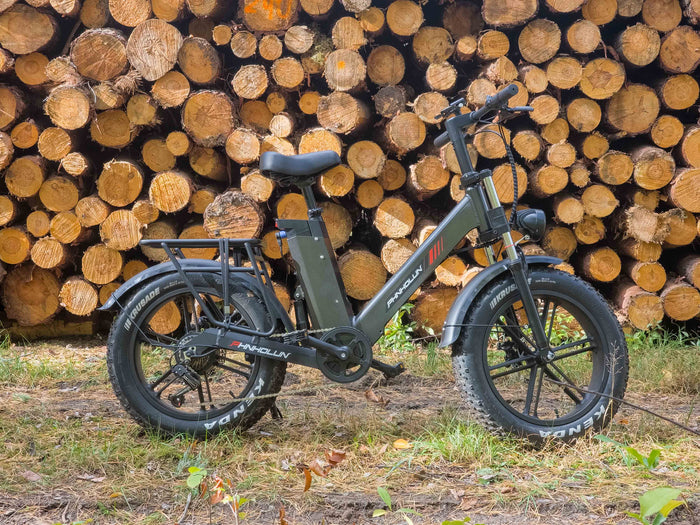In recent years, the popularity of electric bicycles (e-bikes) has been continuously soaring worldwide. E-bikes provide an eco-friendly, efficient, and enjoyable alternative mode of transportation, making them a hot commodity.
Among the various types of electric bicycles, pedal-assist bicycles (also known as smart e-bikes) have garnered significant attention. In this guide, we will delve into the concept of pedal-assist, explore its advantages, compare it to throttle-controlled models, and elucidate the distinctions between electric bicycles and electric pedal-assist bicycles.
What is Pedal Assist?
The role of pedals is often joked about, with the notion that having pedals is what distinguishes an electric bicycle from an electric motorcycle. While this is a personal method of differentiation, it is not entirely accurate, as there are now some bicycles without pedals - pedal-less e-bikes.

Most electric bicycles have pedals, but what is the purpose of these pedals? Their function is not solely for the sake of classification. Pedal assist refers to a feature in electric assist bicycles where the electric assist system senses the rider's pedaling effort and provides corresponding electric assist based on the set assist level. When the rider starts pedaling, the electric assist system automatically detects this and provides additional electric assist, thereby reducing the rider's effort. Pedal assist technology makes riding more effortless, especially when climbing hills or during long-distance rides. Pedal-equipped bicycles are currently the optimal solution for human-powered propulsion, as they best suit daily riding, and this is the true reason, not just because it's called a "bicycle."
Is a Pedal-Assist Bicycle Worth Buying?
Whether to purchase a pedal-assist bicycle depends on individual needs and riding habits.
- Pedal assist makes riding more natural and effortless, as the motor seamlessly supplements the rider's pedaling instead of completely replacing it, providing a smoother and more enjoyable ride, especially for long-distance travel and hilly terrain.
- Pedal assist is an excellent choice for those who want to incorporate exercise into their daily lives or for those with mobility challenges who still want to enjoy the pleasures of cycling. Pedal assist provides a moderate workout while not overly taxing the rider's physical abilities, making it a good option for those who need to both exercise and commute.
- Pedal-assist bicycles are generally more energy-efficient than throttle-controlled electric bicycles, as they only consume power when the rider is actively pedaling. This can extend battery life and increase the range, allowing riders to travel farther on a single charge.
In summary, if you want to enjoy the pleasure of cycling while reducing the physical demands, a pedal-assist bicycle can be a valuable investment.
How Fast Can Pedal-Assist Bicycles Go?
In terms of regulatory standards, the top speed of pedal-assist bicycles is subject to legal restrictions and manufacturer limitations. In practical use, the speed of pedal-assist bicycles depends on various factors, including motor power, the selected assist level, terrain conditions, and the rider's pedaling effort. The specific speed will depend on the electric assist system employed and the riding conditions.
Throttle Assist vs. Pedal Assist: Which is Better?
Throttle assist and pedal assist both have their own advantages and suitable scenarios:
1. Throttle Assist:
Throttle assist allows the rider to control the electric assist function through a handlebar-mounted throttle or button. It can provide instant electric assist, without the need for pedaling. Throttle assist is suitable for riders who want quick acceleration, such as when starting from a stop or climbing hills, or for those who prefer to use electric power exclusively when needed.
2. Pedal Assist:
As previously mentioned, pedal assist requires the rider to actively pedal in order to trigger the electric assist. It is more akin to the traditional bicycle riding experience, while still providing electric assist. Pedal assist is suitable for those who want to maintain their exercise routine, enjoy the cycling experience, and reduce some of the physical demands.
In summary, throttle assist is better suited for situations requiring rapid acceleration or the option to use electric power alone, while pedal assist is more appropriate for those who want to maintain physical activity and still benefit from electric assist.
What is the Difference Between Electric Bicycles and Electric Pedal-Assist Bicycles?
Electric bicycles (E-bikes) and electric pedal-assist bicycles are two distinct terms; in everyday usage, they may sometimes be used interchangeably, but there are some differences:
1. Electric Bicycles:
Electric bicycles are bicycles that are powered entirely by an electric motor, regardless of the control mechanism (throttle or pedal assist).
2. Electric Pedal-Assist Bicycles:
Electric pedal-assist bicycles are bicycles that combine human pedaling and electric assist to provide propulsion. They are equipped with sensors that detect the rider's pedaling effort and provide varying levels of electric assist accordingly. Electric pedal-assist bicycles emphasize the collaboration between the rider and the electric assist system, with the rider's participation triggering the electric assist.
Fundamentally, all pedal-assist bicycles are electric bicycles, but not all electric bicycles are pedal-assist bicycles. Some electric bicycles rely solely on throttle control, while others may offer both throttle and pedal-assist modes to increase their versatility.
In conclusion, electric bicycles are powered entirely by an electric motor, while electric pedal-assist bicycles integrate electric assist with human pedaling to provide a more flexible riding experience.
Can You Ride an Electric Pedal-Assist Bicycle Without Using the Pedal Assist?
Yes, you can choose to ride an electric pedal-assist bicycle without using the pedal assist feature. Nowadays, most electric pedal-assist bicycles offer different assist modes and options, including the ability to completely turn off the electric assist, allowing you to rely solely on your own pedaling power or to use the electric power alone.
In summary, pedal-assist bicycles seamlessly combine convenience, efficiency, and physical activity, making them a worthwhile investment for many cyclists. Whether for daily commuting, recreational riding, or fitness purposes, pedal-assist bicycles can provide an enjoyable riding experience, catering to various preferences and abilities.
Conclusion:
Electric pedal-assist bicycles offer convenience and versatility through both pedal assist and throttle assist. Pedal assist can reduce the physical demands, provide exercise, and increase the enjoyment of riding, while throttle assist is suitable for situations requiring rapid acceleration or the exclusive use of electric power. The key difference between electric bicycles and electric pedal-assist bicycles lies in whether they integrate human pedaling. Regardless of the type of electric pedal-assist bicycle chosen, they all provide an eco-friendly and convenient transportation option, suitable for various riding needs.




















